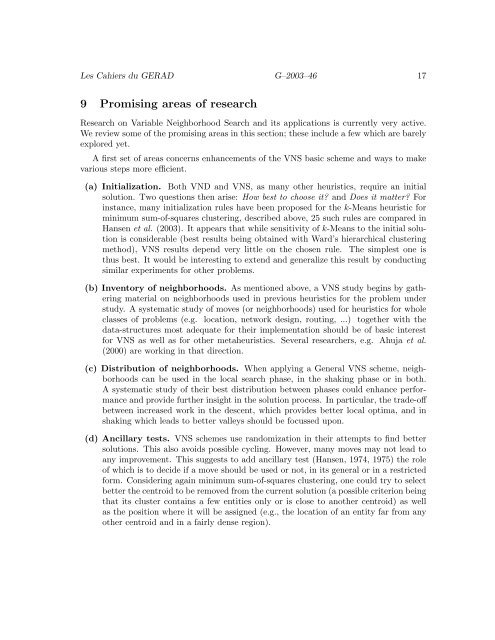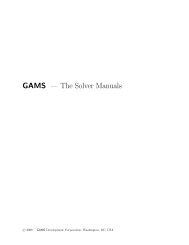A Tutorial on Variable Neighborhood Search
A Tutorial on Variable Neighborhood Search
A Tutorial on Variable Neighborhood Search
You also want an ePaper? Increase the reach of your titles
YUMPU automatically turns print PDFs into web optimized ePapers that Google loves.
Les Cahiers du GERAD G–2003–46 17<br />
9 Promising areas of research<br />
Research <strong>on</strong> <strong>Variable</strong> <strong>Neighborhood</strong> <strong>Search</strong> and its applicati<strong>on</strong>s is currently very active.<br />
We review some of the promising areas in this secti<strong>on</strong>; these include a few which are barely<br />
explored yet.<br />
A first set of areas c<strong>on</strong>cerns enhancements of the VNS basic scheme and ways to make<br />
various steps more efficient.<br />
(a) Initializati<strong>on</strong>. Both VND and VNS, as many other heuristics, require an initial<br />
soluti<strong>on</strong>. Two questi<strong>on</strong>s then arise: How best to choose it and Does it matter For<br />
instance, many initializati<strong>on</strong> rules have been proposed for the k-Means heuristic for<br />
minimum sum-of-squares clustering, described above, 25 such rules are compared in<br />
Hansen et al. (2003). It appears that while sensitivity of k-Means to the initial soluti<strong>on</strong><br />
is c<strong>on</strong>siderable (best results being obtained with Ward’s hierarchical clustering<br />
method), VNS results depend very little <strong>on</strong> the chosen rule. The simplest <strong>on</strong>e is<br />
thus best. It would be interesting to extend and generalize this result by c<strong>on</strong>ducting<br />
similar experiments for other problems.<br />
(b) Inventory of neighborhoods. As menti<strong>on</strong>ed above, a VNS study begins by gathering<br />
material <strong>on</strong> neighborhoods used in previous heuristics for the problem under<br />
study. A systematic study of moves (or neighborhoods) used for heuristics for whole<br />
classes of problems (e.g. locati<strong>on</strong>, network design, routing, ...) together with the<br />
data-structures most adequate for their implementati<strong>on</strong> should be of basic interest<br />
for VNS as well as for other metaheuristics. Several researchers, e.g. Ahuja et al.<br />
(2000) are working in that directi<strong>on</strong>.<br />
(c) Distributi<strong>on</strong> of neighborhoods. When applying a General VNS scheme, neighborhoods<br />
can be used in the local search phase, in the shaking phase or in both.<br />
A systematic study of their best distributi<strong>on</strong> between phases could enhance performance<br />
and provide further insight in the soluti<strong>on</strong> process. In particular, the trade-off<br />
between increased work in the descent, which provides better local optima, and in<br />
shaking which leads to better valleys should be focussed up<strong>on</strong>.<br />
(d) Ancillary tests. VNS schemes use randomizati<strong>on</strong> in their attempts to find better<br />
soluti<strong>on</strong>s. This also avoids possible cycling. However, many moves may not lead to<br />
any improvement. This suggests to add ancillary test (Hansen, 1974, 1975) the role<br />
of which is to decide if a move should be used or not, in its general or in a restricted<br />
form. C<strong>on</strong>sidering again minimum sum-of-squares clustering, <strong>on</strong>e could try to select<br />
better the centroid to be removed from the current soluti<strong>on</strong> (a possible criteri<strong>on</strong> being<br />
that its cluster c<strong>on</strong>tains a few entities <strong>on</strong>ly or is close to another centroid) as well<br />
as the positi<strong>on</strong> where it will be assigned (e.g., the locati<strong>on</strong> of an entity far from any<br />
other centroid and in a fairly dense regi<strong>on</strong>).
















